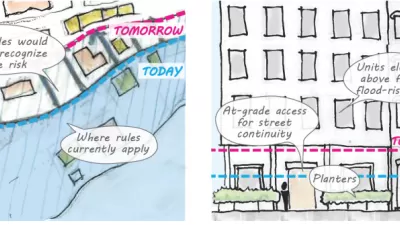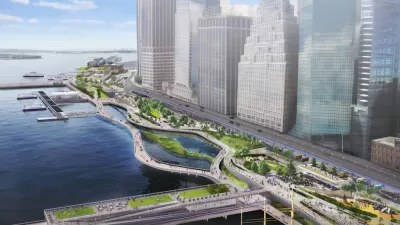The New York City Department of City Planning has released a large set of recommendations for zoning changes designed to help the city's many coastal areas weather the inevitable extreme weather events of climate change and sea level rise.

The New York City Department of City Planning (DCP) recently announced Zoning for Coastal Flood Resiliency, described in a press release as "a set of recommendations to help floodproof buildings in vulnerable neighborhoods against storms and incorporate sea level rise into their design as projected by the New York City Panel on Climate Change."
"Zoning for Coastal Flood Resiliency would expand the area where flood resilient zoning provisions apply, more than doubling the number of buildings that could utilize these provisions. It would accomplish this by allowing buildings in both the city’s 1% annual chance floodplain and 0.2% annual chance floodplain to fully meet or exceed flood-resistant construction standards, even when these standards are not required by FEMA and NYC’s Building Code," according to the press release.
The recommendations are a small step forward for the recommendations, following a public engagement process that briefed 2,500 stakeholders at 138 community events. "Environmental review and the formal public review process are anticipated to start before the end of the year," according to the press release.
The Zoning for Coastal Flood Resiliency recommendations are part of the Department of City Planning’s ongoing "climate resiliency initiatives." A lot more details about the recommendations are included in the press release and on a website set up to explain the recommendations.
FULL STORY: Department of City Planning Announces Zoning for Coastal Flood Resiliency

Study: Maui’s Plan to Convert Vacation Rentals to Long-Term Housing Could Cause Nearly $1 Billion Economic Loss
The plan would reduce visitor accommodation by 25,% resulting in 1,900 jobs lost.

North Texas Transit Leaders Tout Benefits of TOD for Growing Region
At a summit focused on transit-oriented development, policymakers discussed how North Texas’ expanded light rail system can serve as a tool for economic growth.

Using Old Oil and Gas Wells for Green Energy Storage
Penn State researchers have found that repurposing abandoned oil and gas wells for geothermal-assisted compressed-air energy storage can boost efficiency, reduce environmental risks, and support clean energy and job transitions.

Santa Barbara Could Build Housing on County Land
County supervisors moved forward a proposal to build workforce housing on two county-owned parcels.

San Mateo Formally Opposes Freeway Project
The city council will send a letter to Caltrans urging the agency to reconsider a plan to expand the 101 through the city of San Mateo.

A Bronx Community Fights to Have its Voice Heard
After organizing and giving input for decades, the community around the Kingsbridge Armory might actually see it redeveloped — and they want to continue to have a say in how it goes.
Urban Design for Planners 1: Software Tools
This six-course series explores essential urban design concepts using open source software and equips planners with the tools they need to participate fully in the urban design process.
Planning for Universal Design
Learn the tools for implementing Universal Design in planning regulations.
Ascent Environmental
Borough of Carlisle
Institute for Housing and Urban Development Studies (IHS)
City of Grandview
Harvard GSD Executive Education
Toledo-Lucas County Plan Commissions
Salt Lake City
NYU Wagner Graduate School of Public Service




























